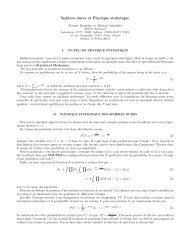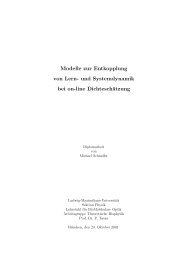Thesis (pdf) - Espci
Thesis (pdf) - Espci
Thesis (pdf) - Espci
Create successful ePaper yourself
Turn your PDF publications into a flip-book with our unique Google optimized e-Paper software.
34 3 Self-organization and cooperativity of weakly coupled molecular motors<br />
When the external force approaches the force due to the power stroke, U1/ℓ,<br />
the advancing probability is considerably reduced. For the sake of simplicity,<br />
we will neglect here the noise in the U1 state, and the motor always move<br />
forward towards the minimum, advancing a multiple of the potential period,<br />
nℓ, each cycle.<br />
Expressing the transition position from the state U2 to U1, x ≡ (n−1)ℓ+z<br />
(see Fig. 3.7), the mean displacement per cycle is 〈δx〉 = ℓ∑ ∞ n=−∞ np(n), with<br />
p(n) the probability of falling at any position between n(ℓ − 1) and nℓ,<br />
〈δx〉 = ℓ<br />
∞<br />
∑<br />
n=−∞<br />
ℓ<br />
n<br />
0<br />
<br />
<br />
1 (ℓ(n − 1)+z + Fτ/λ)2<br />
dz√<br />
exp − . (3.19)<br />
2πDτ 2Dτ<br />
For an external force F = λℓ/(2τ), the motor at state U1 after the transition<br />
time τ is positioned at half the period of the potential from the initial position.<br />
In this case, the probability of advancing forward or backwards (+nℓ or<br />
−nℓ) is exactly the same and the mean displacement is δx = 0. This force<br />
corresponds to the stall force of the motor if λℓ/(2τ) < U/ℓ, otherwise, the<br />
stall force is U/ℓ. Defining the two dimensionless parameters α = vτ/ℓ, the<br />
ratio of the lifetime of the state U2 and the sliding time on the state U1, and<br />
β ≡ ℓ/(4Dτ) 1/2 , the ratio of the potential period and the diffusive displacement<br />
in U2, we can express the stall force as,<br />
F 0<br />
s = λv min<br />
<br />
1, 1<br />
2α<br />
where the super-index 0 stands for mean field.<br />
Mean time lapse per cycle<br />
<br />
, (3.20)<br />
The time lapse corresponding to advancing a distance nℓ is the sum of the U2<br />
life-time τ and the sliding time on the U1 state, δt = τ +ts, with ts =(ℓ−z)/v,<br />
see Fig. 3.7. The mean time lapse is then 〈δt〉 = ∑ ∞ n=−∞ δt(n)p(n), with p(n)<br />
the probability of falling at any position between n(ℓ − 1) and nℓ,<br />
〈δt〉 =<br />
∞<br />
∑<br />
n=−∞<br />
ℓ<br />
0<br />
<br />
dz τ +<br />
ℓ − z<br />
v<br />
<br />
<br />
<br />
1 (ℓ(n − 1)+z + Fτ/λ)2<br />
√ exp −<br />
2πDτ 2Dτ<br />
(3.21)<br />
Finally the mean velocity V 0 ≡〈˙x〉 is the ratio of Eq. 3.19 and Eq. 3.21,<br />
which in terms of the dimensionless parameters α, β and the dimensionless<br />
force f ≡ F/(λv), can be expressed as




